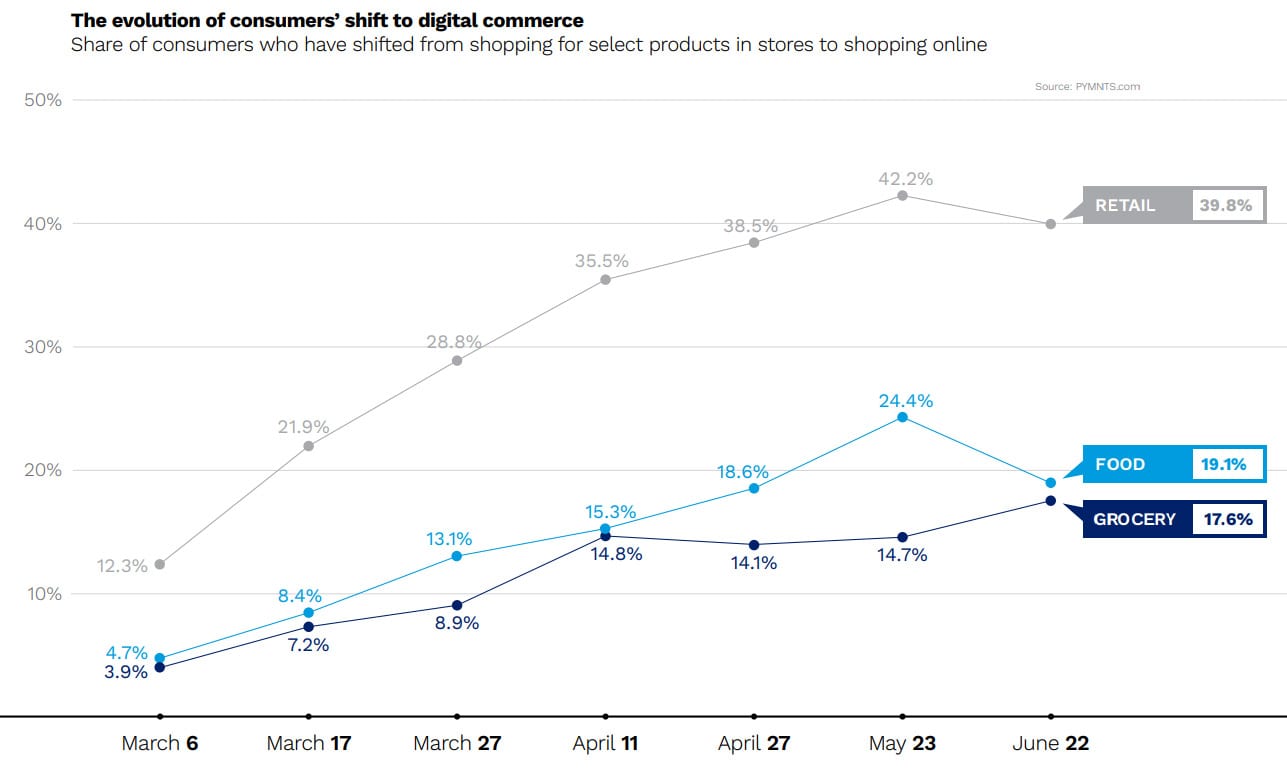Ahold Delhaize CIO: Online Sales Way Up; Will Retreat Post-COVID

Ahold Delhaize, one of the world’s largest supermarket chains, has seen its eCommerce business spike during the pandemic. But Chief Information Officer Ben Wishart tells Karen Webster that he sees the increase partly settling back down once the pandemic ebbs, as many consumers still like shopping for groceries in brick-and-mortar stores.
With more than $73 billion in revenue from 7,000 stores worldwide, few retailers have had a better view of — or benefit from — the grocery industry’s pandemic-era changes than Dutch-based Ahold Delhaize.
The parent of Food Lion, Giant, Stop & Shop and other U.S. chains has recorded more than 40 percent growth in online sales since the pandemic began, Ahold Chief Information Officer Ben Wishart told PYMNTS Karen Webster in an interview.
“We’ve seen a massive increase in demand for eCommerce for our business,” Wishart said.
But while such surging sales are the kind of “problem” many retailers dream of, Wishart said the spike hasn’t come without challenges. He said “every organization in the world” probably faces constraints in physical capacity that make shifting to digital and touchless solutions challenging.
“The physical constraint — the expected growth of eCommerce and what you need to fulfill that in terms of picking capability, fulfillment delivery or pick-up capacity — is the hardest thing to build at fast speed,” Wishart said.
And even once a company has built up the needed capacity and retooled for the new world of eCommerce, Wishart said the next questions are: “How long will this last, and to what degree?”
Wishart said that with every big event, retailers typically see some sort of development in online shopping, such as higher penetration. But after the event ends, usage tends to fall back — although not usually to where it was before.
“If you took COVID away 100 percent and opened all the restaurants again and all that sort of thing, we don’t know where [online grocery sales are] going to normalize to,” he said.
Online Grocery Still Growing
While the degree of that retreat remains to be seen, the September How We Shop report conducted by PYMNTS and PayPal showed, of three surging online categories, only grocery shopping was still growing.

According to the report, the share of consumers ordering from restaurants online decreased from 24 percent to 19 percent in this time frame, and the share buying retail goods online decreased from 42 percent to 40 percent.
However, consumers’ appetite for online grocery shopping has continually increased, and the share of consumers buying groceries online has risen 14 percentage points since early March, to 18 percent between May 23 and June 22.
Online Sales Are Bigger Due To COVID-19, But Still Small Overall
Like most retailers, Ahold ramped up tech investments during the pandemic to meet the unique and sudden shift to eCommerce that the pandemic brought. But even with that surge, Ahold’s second quarter online sales only accounted for 4 percent of total revenue.
“What that means is the store is still really, really important,” Wishart said.
He added that the question of how sticky online grocery sales will be in a post-pandemic world is valid. So is the question of how long it will take for digital sales to account for a more significant market share, like 10 percent to 15 percent of total grocery purchases.
Wishart said that a year ago, his answer to the latter question would have been “probably a decade, maybe two. But in the world we’re in today, it might happen in five years.” However, he added that the answer will really depend on how long the pandemic lasts.
Ahold’s Digital-Heavy Focus
As for Ahold, technology has long played a major role in the company’s business — in fact, its Peapod delivery business turned 30 years old last year.
Wishart said adopting cutting-edge tech remains critical to Ahold, whether that means using robotics in distribution centers or deploying robots to clean its stores. Other areas of digital investment include using “assortment optimization” to bring a better mix of products into stores, redesigning payment flows, and leveraging data to make better decisions about merchandising or dynamic markdowns.
For example, Wishart said that Ahold stores “are sometimes overstocked in perishable items,” but data analysis can either avoid that or make dynamic pricing recommendations to get merchandise moving.
“That enables us to have less waste, which is good for the business and good for the environment,” he said. “But it’s also good for customers because they’re getting a more attractive price.”
In addition, Ahold is adapting to customers’ increased use of self-checkout, even though that’s a complex technological undertaking that has to simultaneously simplify the process for consumers while protecting the company from theft.
Small-Store Format
With the rise of automated Amazon Go stores that feature tech-centric, small-store formats, the optimal size for supermarkets is also up for debate.
“I think there is still a lot of development and innovation to be done to provide an experience that customers want but also deliver a return that retailers need in order to drive the growth of that business,” Wishart said. “But the concept of the connected store or the autonomous store has a lot of potential for the future.”
